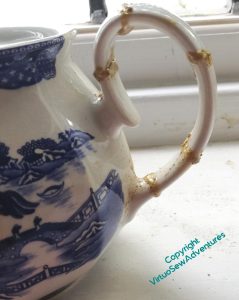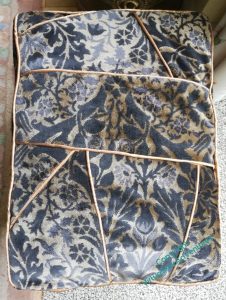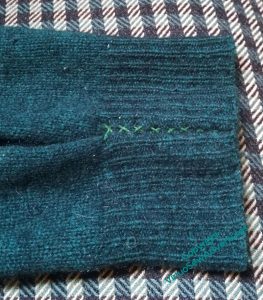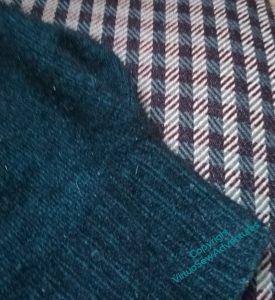Mending, Upcycling, and other adventures
As a family, we have always made and remade, mended and upcycled, garments, furnishing and furniture. There is a tale of five year old me, accompanying my mother to buy fabric for a dress in the now long-gone and much-lamented fabric shop in town, and piping up, as she was paying, to ask “What will it be _next_?”, so you can tell this is deeply ingrained!
Usually this is something I let pass without comment, but two episodes lately seemed worth mentioning, in case they give someone else an idea..
The Japanese mending technique for pottery, “kintsugi”, involves highlighting the mends with gold, so as not to obliterate the history of a piece. I can’t say I’m very good at it, but I had an entertaining afternoon with a kit that enabled me to play with the idea, at least.
And then my cousin mentioned a footstool she had with an entirely unsuitable cover for the surroundings, and a few oddments of furnishing fabric from earlier work on the room. Cue a Kintsugi-inspired crazy patchwork footstool cover, with all the seams emphasized with gold piping! This took some work and collaboration, as my sewing machine isn’t up to the task, but Mam’s was.
And on an entirely different scale – one of the problems with older knitwear is the way the ribbed cuffs seem to lose all their elasticity, and what was once a trim and neat shape, will often become shapeless and saggy with age. I’ve tried in the past adding elastic, but I couldn’t make that work (if anyone has – what’s your trick?), so it rather nags at me.
Then this winter we made a dress with rather extravagantly tucked sleeves, and I thought I had an idea that might work. I’ve created an inverted box pleat in the cuff here – it’s just held with stranded cotton at present, something that will show up so I can play with it until it works, and then do it properly (or not!) – and held it together, starting at the sleeve end, with crossing stitches. Then I caught down the side of the box pleat.
You can see in this picture how the cuff is now neat and close, and the sleeve has a bit more shape, and rather less “flop”. I’m very pleased with that, and I may extend this to other, similar garments.





I also grew up on the make do and mend scale. My father did things with scraps of wood, bits of cardboard, unfolded paperclips, bulldog clips, clothespegs, string and anything else that came to hand, while knits and dresses were refashioned, altered and passed around family and friends. I still hoard junk offcuts and oddments on the “come in handy if you never use it” scale. When I found myself in a fairly remote village for eight years, that stock of odds and ends enabled me learn and practice the stitching skills that fascinated me.
It has grown a bit since then!
Your folded cuffs look very neat. As I tend to shove my cuffs up nearly to my elbows, the baggy ones rarely bother me. But that is a technique worth remembering.
Well done on the upcycling and mending. I think I did put elastic round a cuff once but I can’t remember the outcome. I have short arms so my problem is usually that the sleeves are too long.
It is always good to extend somethings life – love the teapot and the stool ideas. The cuff has worked well too. xx
Very clever!
It is fascinating that you used kintsugi – from a kit! – for the teapot. It is a very old and traditional way to repair china and porcelain in Japan. As far as I know, though, it is only done by craftsmen who have been in training for years before they can take on customers’ requests. The Japanese love mending and repairs that are attractive to the eye. For broken paper windows a patch of washi paper, shaped like a cherry petal or a maple leaf, is often used to cover the tear in the paper.
I love the work you have done on the teapot, and it was clever to use the same idea for the footstool cover.
As for the sweater, I have never used elastics. You came up with a great solution to the problem, and it’s decorative as well!
Interesting to read about the teapot repair. I can relate to the sweater repair as I do tend to always push sleeves up and therefore in time the cuffs get baggy, so I close the inside seam a bit, and also unravel a too high polo or turtle necked sweater which threats to strangle me.
Waste not want not. Nowadays I also amend and upcycle garments whenever possible to save the earth and save money too. Your idea is great.
I like the ideas of using kintsugi with fabric. What a great idea.
Thrift was ever-present in our house too with various textile items recycled into different pieces, always looking for inventive ways to use them. I love your idea with the sweater cuffs as that’s a bone of contention for me as well.